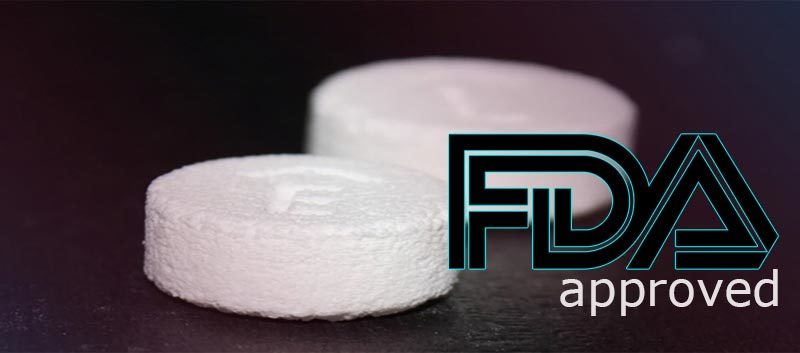Recent FDA Approvals in the World of 3D Medical Printing

Three-dimensional (3D) printing technology was invented in the 1980s to create mechanical prototypes for the manufacturing sector. Healthcare professionals and researchers soon realized the potential of this novel technology in the field of medicine and began depositing desired materials on specific substrates to create anatomical models, surgical instruments, prosthetics and even body parts that could be customized to meet the needs of the user. Scientists rely on MRI and CT scan images of the patients to obtain the exact dimensions for the target object, feed the image data into one or more software programs, and let the 3D printer do its job.
Millions of dollars have been spent on 3D medical printing and bioprinting research in last decade, and such endeavors have led to the creation of several innovative solutions. Nonetheless, many of these products can't benefit the patients until they come with the Food and Drug Administration’s (FDA) seal of approval. Recently, the federal agency woke up to the needs of the 3D medical printing industry and issued guidance for 3D printed medical devices based on design, manufacturing and device testing information. Many 3D printed products have received FDA approval, some of which are highlighted below.
The O2 Vent a 3D Printed Solution for Sleep ApneaIn April, 2016, Oventus, an Australian startup, received FDA approval for its titanium mouth device called the O2 Vent. The customizable oral device contains airways that reach the back of the patient’s mouth bypassing obstructions caused by nose, soft palate or tongue. The 3D printed device is expected to benefit over 37 million Americans suffering from sleep apnea while helping Oventus enter the $50 billion global sleep disorder market.
Spritam, the FDA approved 3D Printed Drug
In another bold step, the FDA approved a 3D printed drug, Spritam, to treat partial onset seizures, myoclonic seizures and primary generalized tonic-clonic seizures. Its manufacturer, Aprecia Pharmaceuticals, used the ZipDose 3D printing technology to create a pill that disintegrates in the mouth with very little water and is especially beneficial to patients who cannot swallow their medication during seizures. The high-dose drug can impact over 2.4 million American adults with epilepsy, as per an article published in the March, 2016, edition of Forbes.
Lateral Spine Truss System
Another innovative product, the Lateral Spine Truss System, also received a go-ahead from the federal agency in 2016. It consists of 3D printed orthopedic implants, manufactured by 4WEB Medical, that allow for integrated instrumentation and customization. They come in sterile packs and can be used with most mainstream spinal surgery techniques. The goal is to deliver functional implants with a structural design.
CASCADIA Cervical and CASCADIA AN Lordotic Oblique Interbody Systems
The FDA has also issued a 510 (K) clearance to K2M for CASCADIA Cervical and CASCADIA AN Lordotic Oblique Interbody Systems with Lamellar 3D Titanium technology. While CASCADIA Cervical Interbody System is an intervertebral body fusion device, the CASCADIA AN Lordotic Oblique Interbody System has been designed for transforaminal-lumbar interventions. K2M expects its product to help the approximately 800,000 men and women who undergo cervical fusion each year.
3D Printed Cranial Implants
Brazilian and U.S. based BioArchitects collaborated with Swedish 3D printing company ArcamAB to generate patient-specific cranial implants. The company used Electron Beam Melting technology and lightweight titanium alloys to form the implants. Although the FDA approval is restricted to the non-loadbearing bones of the skull and face, healthcare professionals are hopeful that the technology can treat a variety of conditions ranging from trauma to congenital abnormalities.
While 3D printed products with FDA approvals strive to become more accessible to all patients, others are waiting in the pipeline for a green light from the agency. Licensing requirements include extensive lab testing and clinical evaluation. Doctors and scientists are, however, confident the products will meet the criteria and get the necessary endorsements from the FDA to eventually help transform medicine.
Sources:
http://www.news-medical.net/news/20160407/Oventus-gains-FDA-clearance-for-medical-device-designed-to-alleviate-snoring-OSA.aspx
http://www.todaysmedicaldevelopments.com/article/3d-printed-medical-device-4web-8316/
http://www.meddeviceonline.com/doc/k-m-enhances-d-printed-spine-portfolio-featuring-lamellar-d-titanium-technology-0001





0 Comments
Recommended Comments
There are no comments to display.
Create an account or sign in to comment
You need to be a member in order to leave a comment
Create an account
Sign up for a new account in our community. It's easy!
Register a new accountSign in
Already have an account? Sign in here.
Sign In Now